Analysis of Australia's Skilled Immigration Policy
VerifiedAdded on 2021/11/12
|13
|2945
|20
Report
AI Summary
This report delves into Australia's skilled immigration policy, a cornerstone of its economic and social landscape. It examines the policy's rationale, highlighting its role in attracting skilled migrants and shaping the economy. The report traces the formulation and implementation of the policy, from the introduction of the point test-based system to subsequent reforms. A critical analysis of the policy's successes, such as addressing labor shortages and attracting skilled workers, is presented alongside its failures, including skill divergence and a lack of coordination between immigration and employment policies. The report further explores the impact of the policy on the labor market, the role of temporary visas, and the challenges faced by over-educated immigrants. Finally, it provides recommendations for strengthening the policy, including improved coordination between immigration and employment policies and the development of employment advisory services. The report concludes by emphasizing the need for continuous evaluation and adaptation to ensure the policy effectively serves Australia's economic and social objectives.
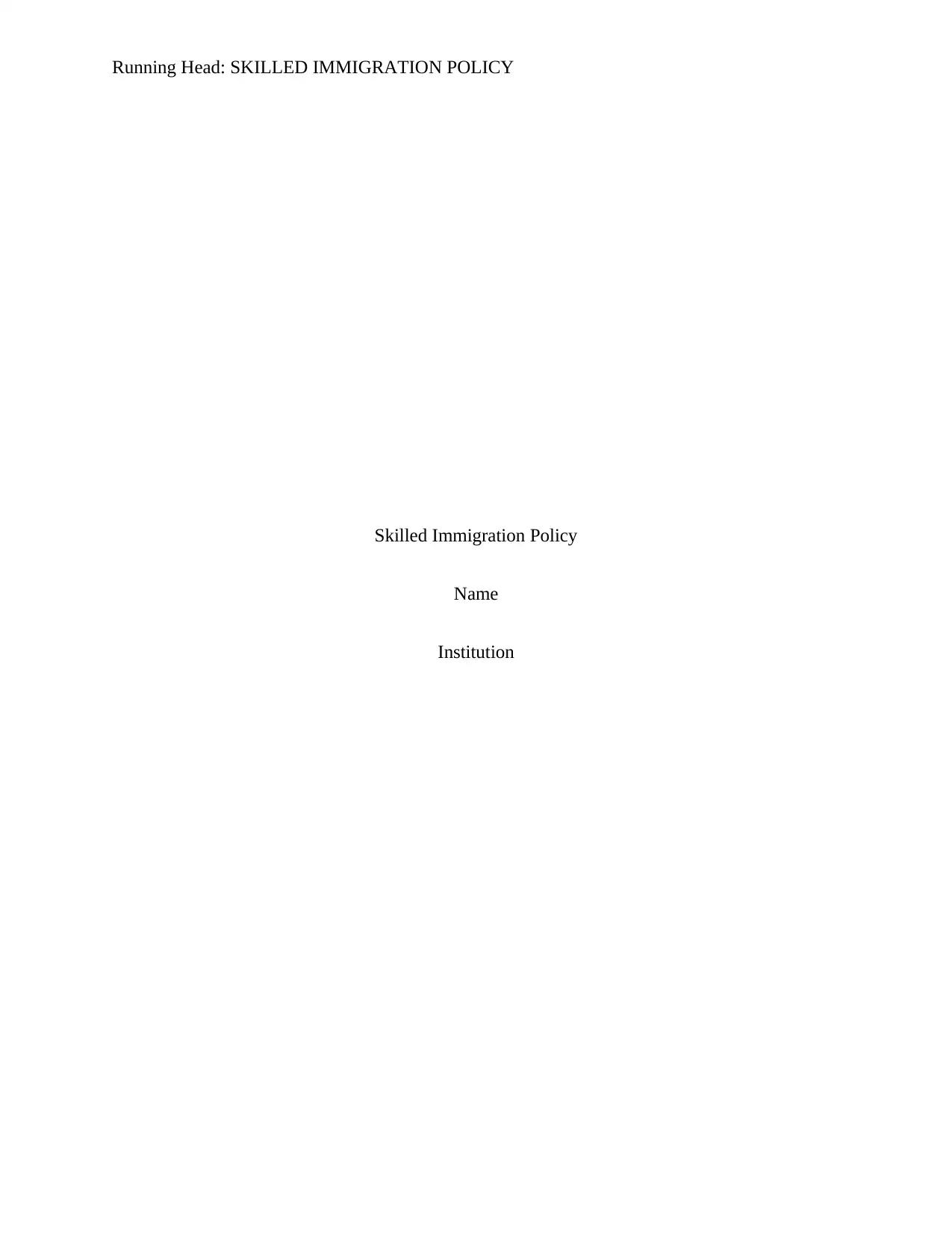
Running Head: SKILLED IMMIGRATION POLICY
Skilled Immigration Policy
Name
Institution
Skilled Immigration Policy
Name
Institution
Paraphrase This Document
Need a fresh take? Get an instant paraphrase of this document with our AI Paraphraser
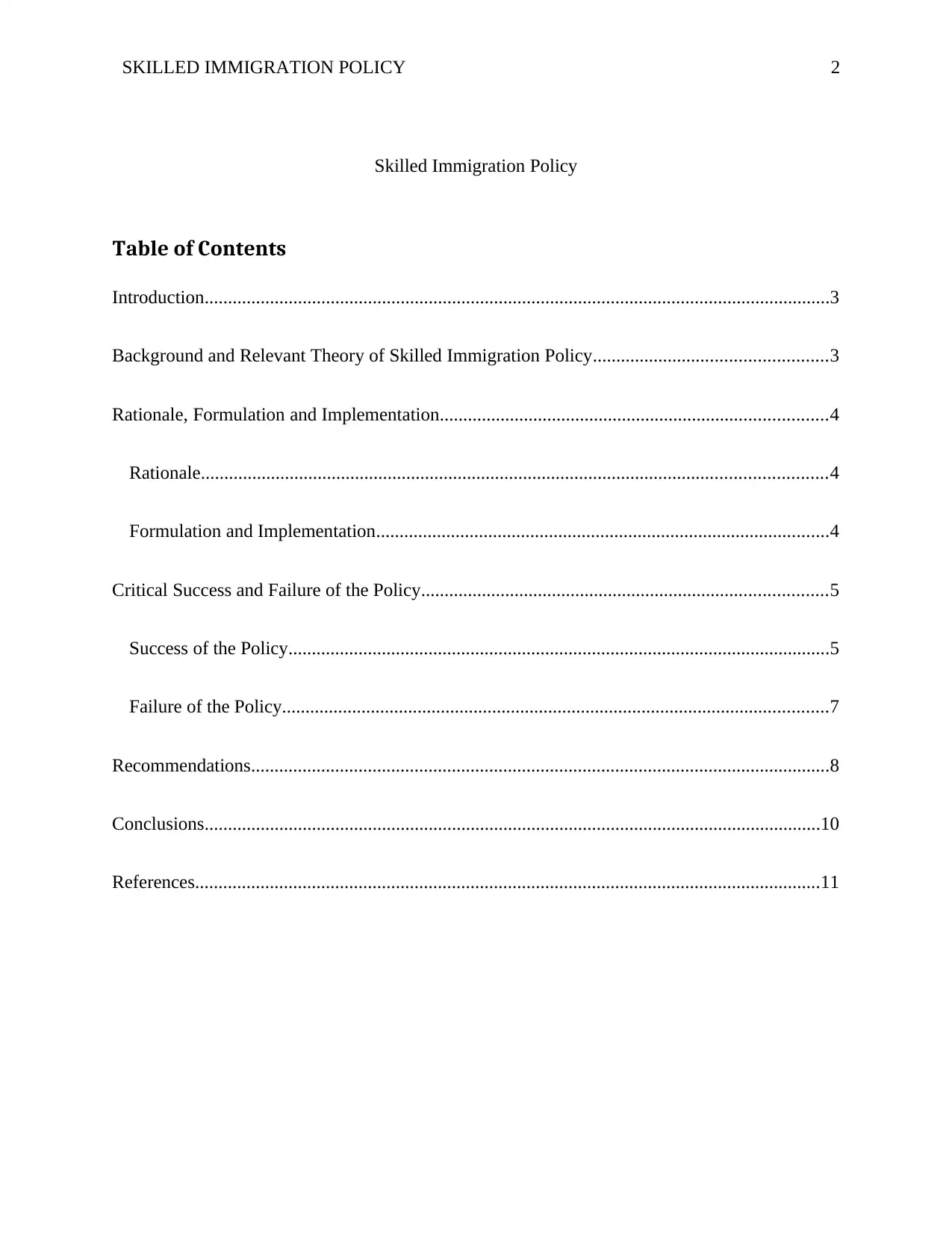
SKILLED IMMIGRATION POLICY 2
Skilled Immigration Policy
Table of Contents
Introduction......................................................................................................................................3
Background and Relevant Theory of Skilled Immigration Policy..................................................3
Rationale, Formulation and Implementation...................................................................................4
Rationale......................................................................................................................................4
Formulation and Implementation.................................................................................................4
Critical Success and Failure of the Policy.......................................................................................5
Success of the Policy....................................................................................................................5
Failure of the Policy.....................................................................................................................7
Recommendations............................................................................................................................8
Conclusions....................................................................................................................................10
References......................................................................................................................................11
Skilled Immigration Policy
Table of Contents
Introduction......................................................................................................................................3
Background and Relevant Theory of Skilled Immigration Policy..................................................3
Rationale, Formulation and Implementation...................................................................................4
Rationale......................................................................................................................................4
Formulation and Implementation.................................................................................................4
Critical Success and Failure of the Policy.......................................................................................5
Success of the Policy....................................................................................................................5
Failure of the Policy.....................................................................................................................7
Recommendations............................................................................................................................8
Conclusions....................................................................................................................................10
References......................................................................................................................................11
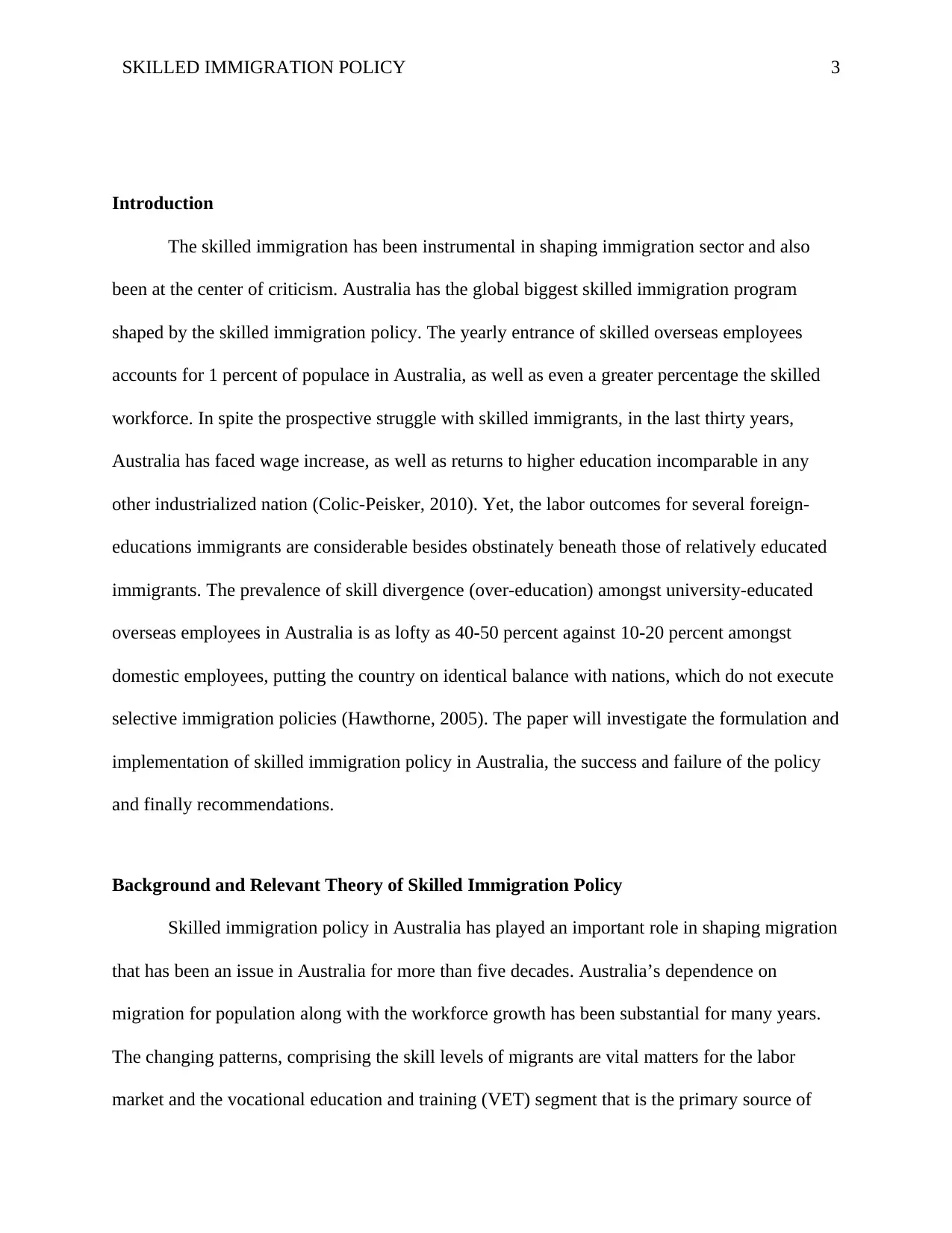
SKILLED IMMIGRATION POLICY 3
Introduction
The skilled immigration has been instrumental in shaping immigration sector and also
been at the center of criticism. Australia has the global biggest skilled immigration program
shaped by the skilled immigration policy. The yearly entrance of skilled overseas employees
accounts for 1 percent of populace in Australia, as well as even a greater percentage the skilled
workforce. In spite the prospective struggle with skilled immigrants, in the last thirty years,
Australia has faced wage increase, as well as returns to higher education incomparable in any
other industrialized nation (Colic-Peisker, 2010). Yet, the labor outcomes for several foreign-
educations immigrants are considerable besides obstinately beneath those of relatively educated
immigrants. The prevalence of skill divergence (over-education) amongst university-educated
overseas employees in Australia is as lofty as 40-50 percent against 10-20 percent amongst
domestic employees, putting the country on identical balance with nations, which do not execute
selective immigration policies (Hawthorne, 2005). The paper will investigate the formulation and
implementation of skilled immigration policy in Australia, the success and failure of the policy
and finally recommendations.
Background and Relevant Theory of Skilled Immigration Policy
Skilled immigration policy in Australia has played an important role in shaping migration
that has been an issue in Australia for more than five decades. Australia’s dependence on
migration for population along with the workforce growth has been substantial for many years.
The changing patterns, comprising the skill levels of migrants are vital matters for the labor
market and the vocational education and training (VET) segment that is the primary source of
Introduction
The skilled immigration has been instrumental in shaping immigration sector and also
been at the center of criticism. Australia has the global biggest skilled immigration program
shaped by the skilled immigration policy. The yearly entrance of skilled overseas employees
accounts for 1 percent of populace in Australia, as well as even a greater percentage the skilled
workforce. In spite the prospective struggle with skilled immigrants, in the last thirty years,
Australia has faced wage increase, as well as returns to higher education incomparable in any
other industrialized nation (Colic-Peisker, 2010). Yet, the labor outcomes for several foreign-
educations immigrants are considerable besides obstinately beneath those of relatively educated
immigrants. The prevalence of skill divergence (over-education) amongst university-educated
overseas employees in Australia is as lofty as 40-50 percent against 10-20 percent amongst
domestic employees, putting the country on identical balance with nations, which do not execute
selective immigration policies (Hawthorne, 2005). The paper will investigate the formulation and
implementation of skilled immigration policy in Australia, the success and failure of the policy
and finally recommendations.
Background and Relevant Theory of Skilled Immigration Policy
Skilled immigration policy in Australia has played an important role in shaping migration
that has been an issue in Australia for more than five decades. Australia’s dependence on
migration for population along with the workforce growth has been substantial for many years.
The changing patterns, comprising the skill levels of migrants are vital matters for the labor
market and the vocational education and training (VET) segment that is the primary source of
⊘ This is a preview!⊘
Do you want full access?
Subscribe today to unlock all pages.

Trusted by 1+ million students worldwide
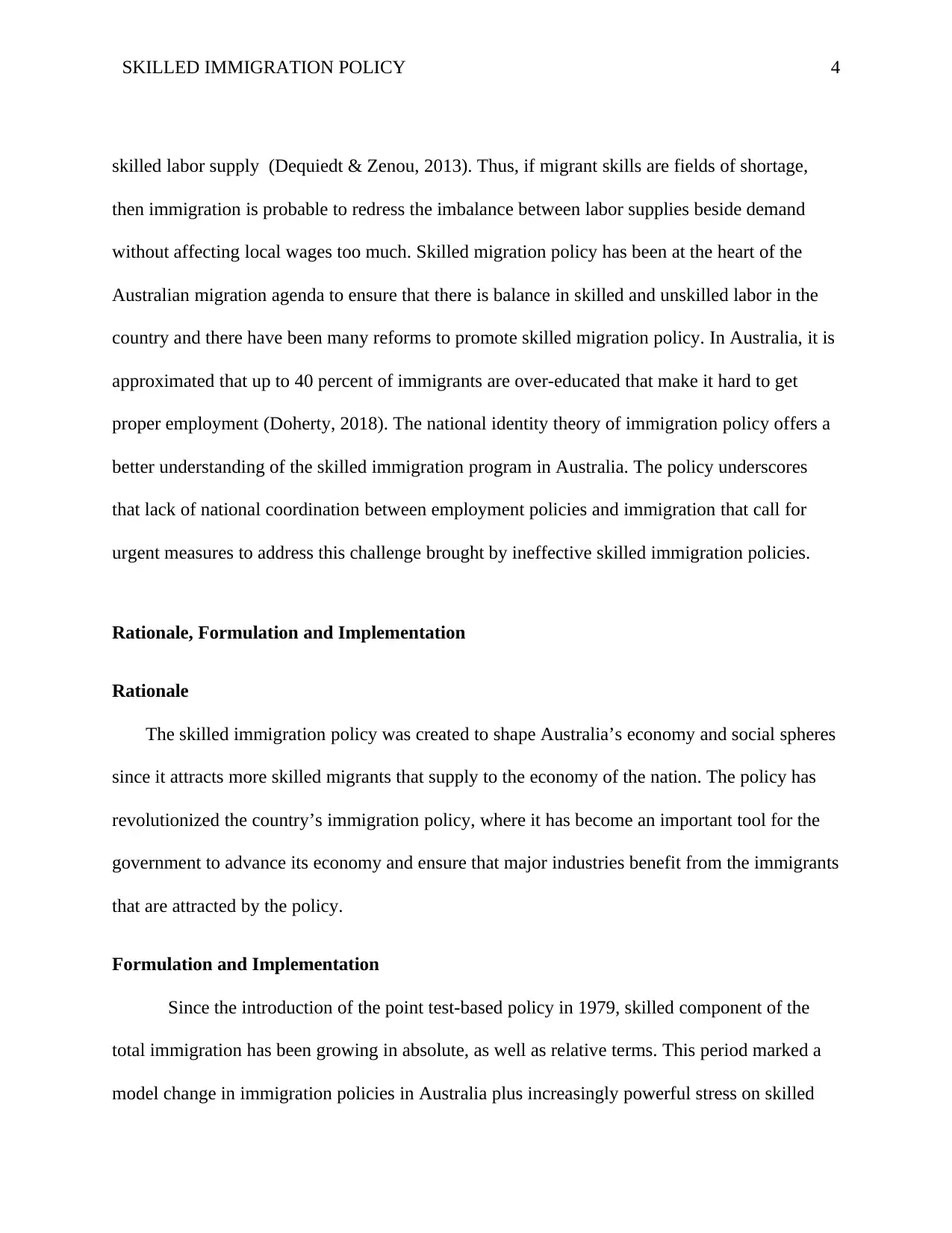
SKILLED IMMIGRATION POLICY 4
skilled labor supply (Dequiedt & Zenou, 2013). Thus, if migrant skills are fields of shortage,
then immigration is probable to redress the imbalance between labor supplies beside demand
without affecting local wages too much. Skilled migration policy has been at the heart of the
Australian migration agenda to ensure that there is balance in skilled and unskilled labor in the
country and there have been many reforms to promote skilled migration policy. In Australia, it is
approximated that up to 40 percent of immigrants are over-educated that make it hard to get
proper employment (Doherty, 2018). The national identity theory of immigration policy offers a
better understanding of the skilled immigration program in Australia. The policy underscores
that lack of national coordination between employment policies and immigration that call for
urgent measures to address this challenge brought by ineffective skilled immigration policies.
Rationale, Formulation and Implementation
Rationale
The skilled immigration policy was created to shape Australia’s economy and social spheres
since it attracts more skilled migrants that supply to the economy of the nation. The policy has
revolutionized the country’s immigration policy, where it has become an important tool for the
government to advance its economy and ensure that major industries benefit from the immigrants
that are attracted by the policy.
Formulation and Implementation
Since the introduction of the point test-based policy in 1979, skilled component of the
total immigration has been growing in absolute, as well as relative terms. This period marked a
model change in immigration policies in Australia plus increasingly powerful stress on skilled
skilled labor supply (Dequiedt & Zenou, 2013). Thus, if migrant skills are fields of shortage,
then immigration is probable to redress the imbalance between labor supplies beside demand
without affecting local wages too much. Skilled migration policy has been at the heart of the
Australian migration agenda to ensure that there is balance in skilled and unskilled labor in the
country and there have been many reforms to promote skilled migration policy. In Australia, it is
approximated that up to 40 percent of immigrants are over-educated that make it hard to get
proper employment (Doherty, 2018). The national identity theory of immigration policy offers a
better understanding of the skilled immigration program in Australia. The policy underscores
that lack of national coordination between employment policies and immigration that call for
urgent measures to address this challenge brought by ineffective skilled immigration policies.
Rationale, Formulation and Implementation
Rationale
The skilled immigration policy was created to shape Australia’s economy and social spheres
since it attracts more skilled migrants that supply to the economy of the nation. The policy has
revolutionized the country’s immigration policy, where it has become an important tool for the
government to advance its economy and ensure that major industries benefit from the immigrants
that are attracted by the policy.
Formulation and Implementation
Since the introduction of the point test-based policy in 1979, skilled component of the
total immigration has been growing in absolute, as well as relative terms. This period marked a
model change in immigration policies in Australia plus increasingly powerful stress on skilled
Paraphrase This Document
Need a fresh take? Get an instant paraphrase of this document with our AI Paraphraser
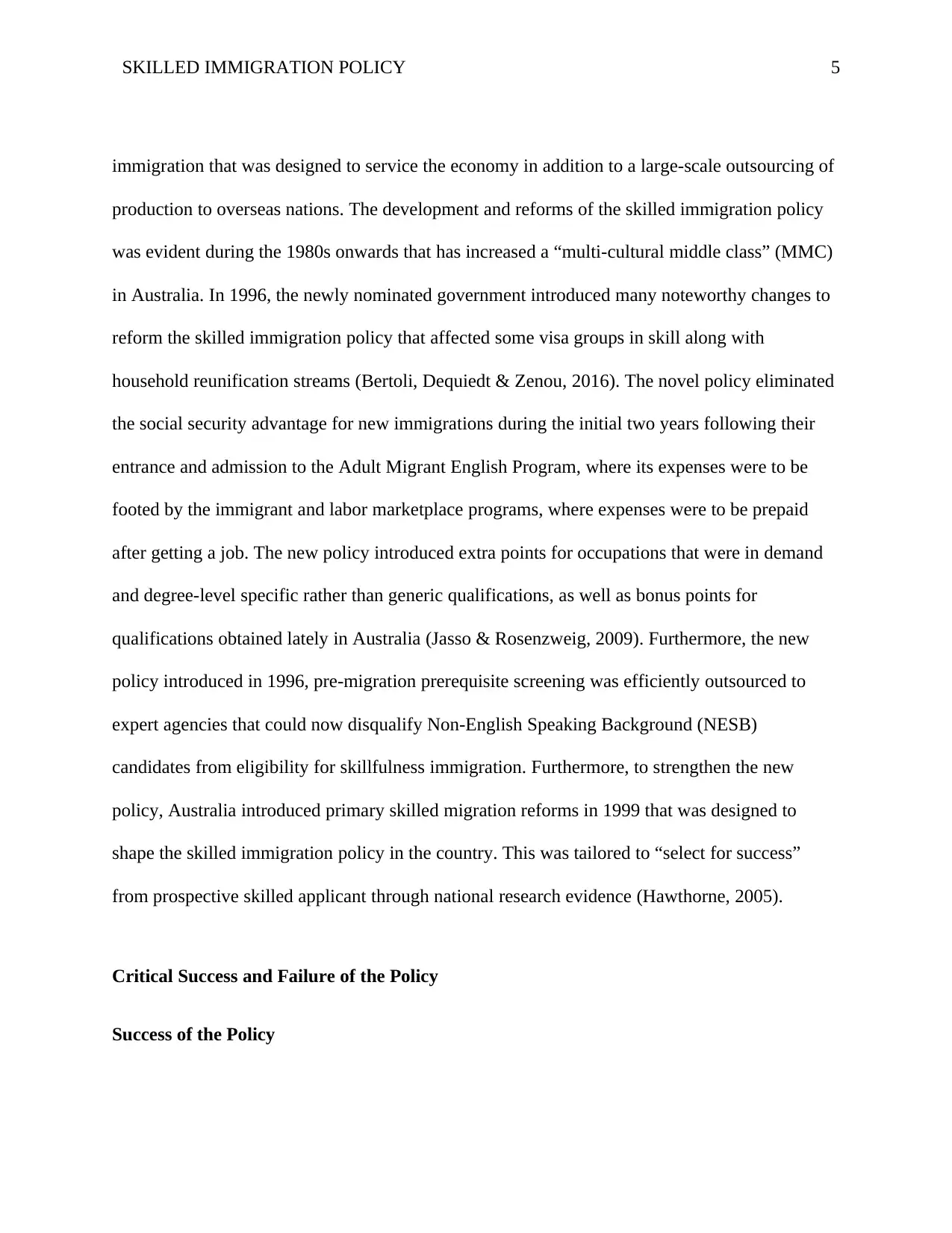
SKILLED IMMIGRATION POLICY 5
immigration that was designed to service the economy in addition to a large-scale outsourcing of
production to overseas nations. The development and reforms of the skilled immigration policy
was evident during the 1980s onwards that has increased a “multi-cultural middle class” (MMC)
in Australia. In 1996, the newly nominated government introduced many noteworthy changes to
reform the skilled immigration policy that affected some visa groups in skill along with
household reunification streams (Bertoli, Dequiedt & Zenou, 2016). The novel policy eliminated
the social security advantage for new immigrations during the initial two years following their
entrance and admission to the Adult Migrant English Program, where its expenses were to be
footed by the immigrant and labor marketplace programs, where expenses were to be prepaid
after getting a job. The new policy introduced extra points for occupations that were in demand
and degree-level specific rather than generic qualifications, as well as bonus points for
qualifications obtained lately in Australia (Jasso & Rosenzweig, 2009). Furthermore, the new
policy introduced in 1996, pre-migration prerequisite screening was efficiently outsourced to
expert agencies that could now disqualify Non-English Speaking Background (NESB)
candidates from eligibility for skillfulness immigration. Furthermore, to strengthen the new
policy, Australia introduced primary skilled migration reforms in 1999 that was designed to
shape the skilled immigration policy in the country. This was tailored to “select for success”
from prospective skilled applicant through national research evidence (Hawthorne, 2005).
Critical Success and Failure of the Policy
Success of the Policy
immigration that was designed to service the economy in addition to a large-scale outsourcing of
production to overseas nations. The development and reforms of the skilled immigration policy
was evident during the 1980s onwards that has increased a “multi-cultural middle class” (MMC)
in Australia. In 1996, the newly nominated government introduced many noteworthy changes to
reform the skilled immigration policy that affected some visa groups in skill along with
household reunification streams (Bertoli, Dequiedt & Zenou, 2016). The novel policy eliminated
the social security advantage for new immigrations during the initial two years following their
entrance and admission to the Adult Migrant English Program, where its expenses were to be
footed by the immigrant and labor marketplace programs, where expenses were to be prepaid
after getting a job. The new policy introduced extra points for occupations that were in demand
and degree-level specific rather than generic qualifications, as well as bonus points for
qualifications obtained lately in Australia (Jasso & Rosenzweig, 2009). Furthermore, the new
policy introduced in 1996, pre-migration prerequisite screening was efficiently outsourced to
expert agencies that could now disqualify Non-English Speaking Background (NESB)
candidates from eligibility for skillfulness immigration. Furthermore, to strengthen the new
policy, Australia introduced primary skilled migration reforms in 1999 that was designed to
shape the skilled immigration policy in the country. This was tailored to “select for success”
from prospective skilled applicant through national research evidence (Hawthorne, 2005).
Critical Success and Failure of the Policy
Success of the Policy
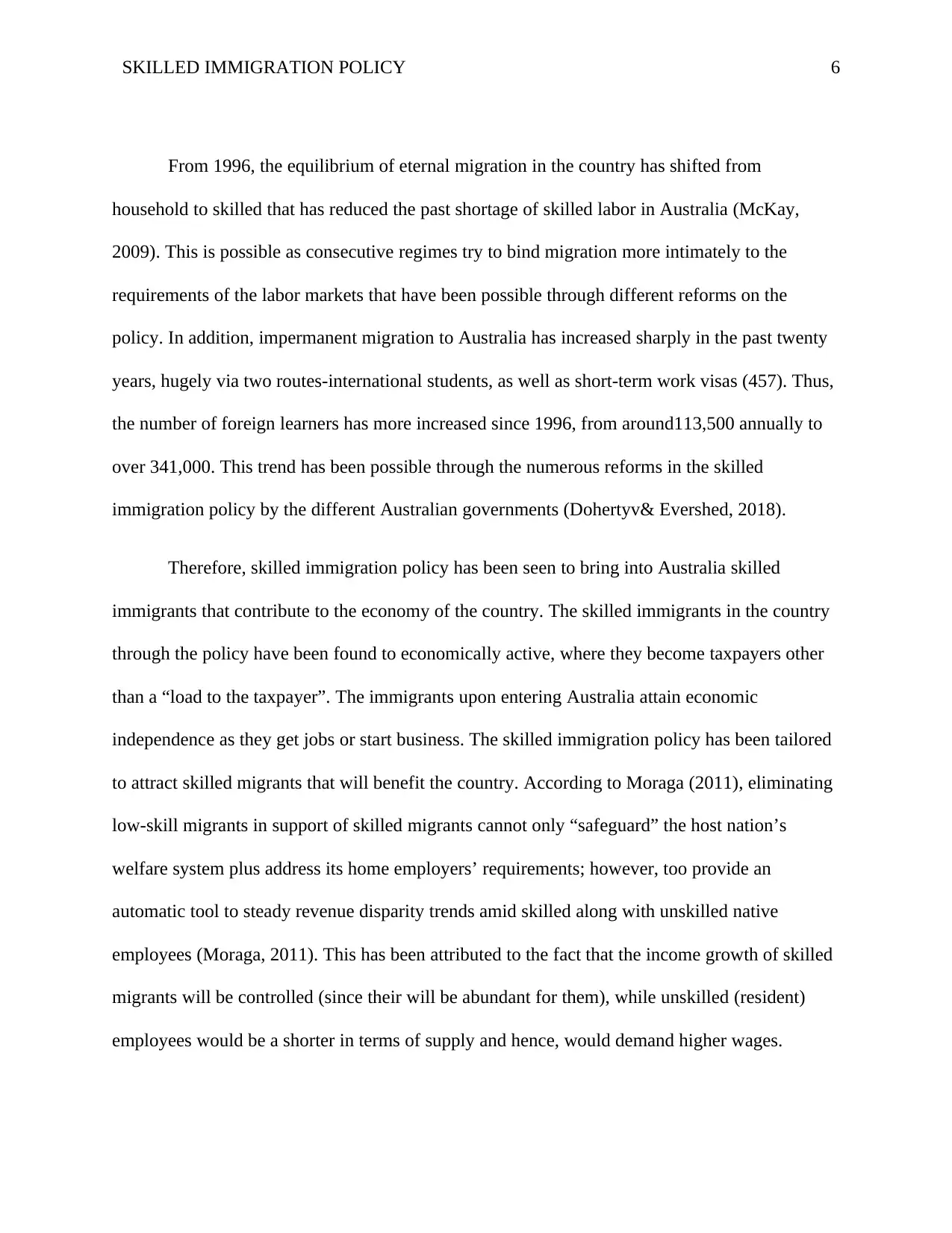
SKILLED IMMIGRATION POLICY 6
From 1996, the equilibrium of eternal migration in the country has shifted from
household to skilled that has reduced the past shortage of skilled labor in Australia (McKay,
2009). This is possible as consecutive regimes try to bind migration more intimately to the
requirements of the labor markets that have been possible through different reforms on the
policy. In addition, impermanent migration to Australia has increased sharply in the past twenty
years, hugely via two routes-international students, as well as short-term work visas (457). Thus,
the number of foreign learners has more increased since 1996, from around113,500 annually to
over 341,000. This trend has been possible through the numerous reforms in the skilled
immigration policy by the different Australian governments (Dohertyv& Evershed, 2018).
Therefore, skilled immigration policy has been seen to bring into Australia skilled
immigrants that contribute to the economy of the country. The skilled immigrants in the country
through the policy have been found to economically active, where they become taxpayers other
than a “load to the taxpayer”. The immigrants upon entering Australia attain economic
independence as they get jobs or start business. The skilled immigration policy has been tailored
to attract skilled migrants that will benefit the country. According to Moraga (2011), eliminating
low-skill migrants in support of skilled migrants cannot only “safeguard” the host nation’s
welfare system plus address its home employers’ requirements; however, too provide an
automatic tool to steady revenue disparity trends amid skilled along with unskilled native
employees (Moraga, 2011). This has been attributed to the fact that the income growth of skilled
migrants will be controlled (since their will be abundant for them), while unskilled (resident)
employees would be a shorter in terms of supply and hence, would demand higher wages.
From 1996, the equilibrium of eternal migration in the country has shifted from
household to skilled that has reduced the past shortage of skilled labor in Australia (McKay,
2009). This is possible as consecutive regimes try to bind migration more intimately to the
requirements of the labor markets that have been possible through different reforms on the
policy. In addition, impermanent migration to Australia has increased sharply in the past twenty
years, hugely via two routes-international students, as well as short-term work visas (457). Thus,
the number of foreign learners has more increased since 1996, from around113,500 annually to
over 341,000. This trend has been possible through the numerous reforms in the skilled
immigration policy by the different Australian governments (Dohertyv& Evershed, 2018).
Therefore, skilled immigration policy has been seen to bring into Australia skilled
immigrants that contribute to the economy of the country. The skilled immigrants in the country
through the policy have been found to economically active, where they become taxpayers other
than a “load to the taxpayer”. The immigrants upon entering Australia attain economic
independence as they get jobs or start business. The skilled immigration policy has been tailored
to attract skilled migrants that will benefit the country. According to Moraga (2011), eliminating
low-skill migrants in support of skilled migrants cannot only “safeguard” the host nation’s
welfare system plus address its home employers’ requirements; however, too provide an
automatic tool to steady revenue disparity trends amid skilled along with unskilled native
employees (Moraga, 2011). This has been attributed to the fact that the income growth of skilled
migrants will be controlled (since their will be abundant for them), while unskilled (resident)
employees would be a shorter in terms of supply and hence, would demand higher wages.
⊘ This is a preview!⊘
Do you want full access?
Subscribe today to unlock all pages.

Trusted by 1+ million students worldwide
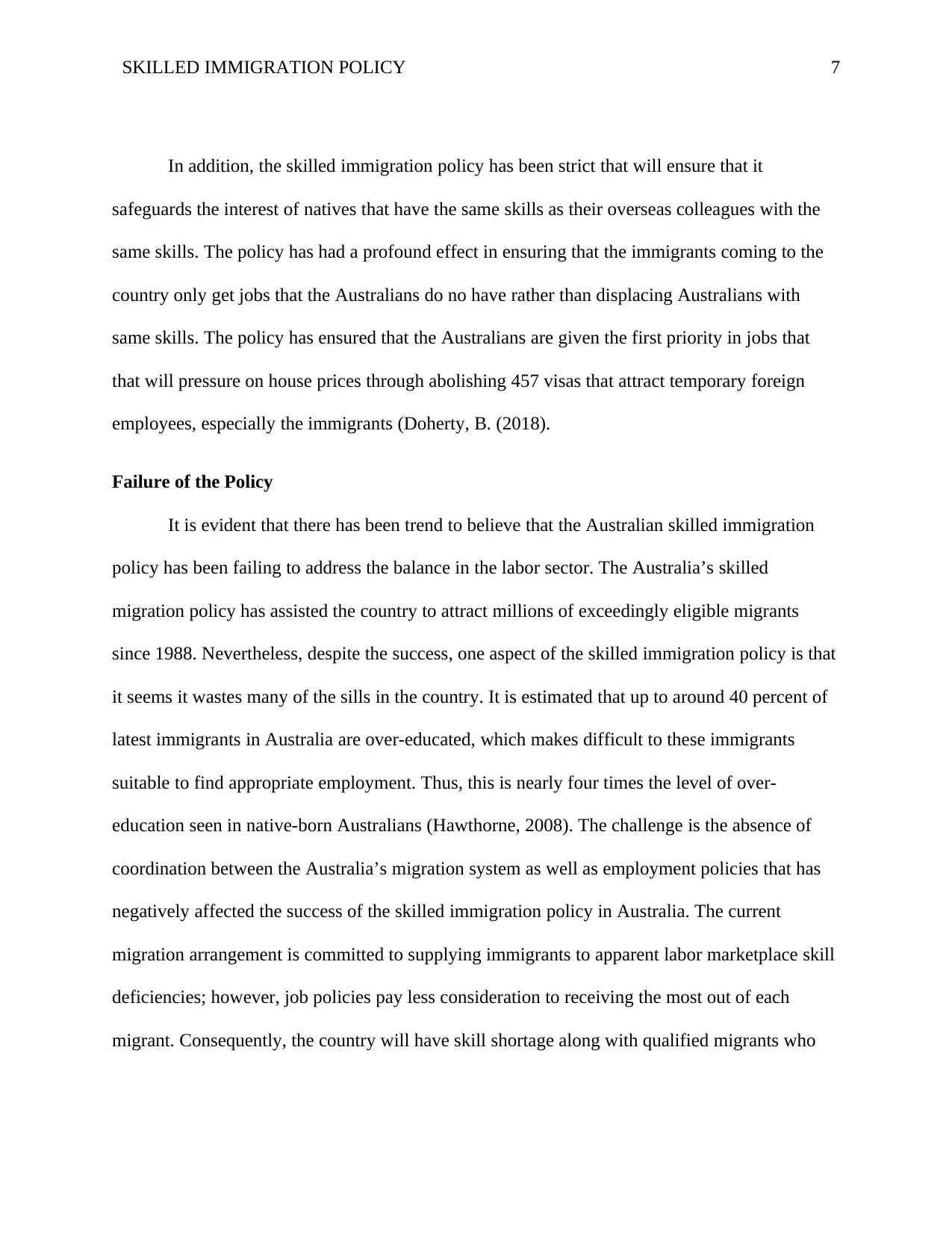
SKILLED IMMIGRATION POLICY 7
In addition, the skilled immigration policy has been strict that will ensure that it
safeguards the interest of natives that have the same skills as their overseas colleagues with the
same skills. The policy has had a profound effect in ensuring that the immigrants coming to the
country only get jobs that the Australians do no have rather than displacing Australians with
same skills. The policy has ensured that the Australians are given the first priority in jobs that
that will pressure on house prices through abolishing 457 visas that attract temporary foreign
employees, especially the immigrants (Doherty, B. (2018).
Failure of the Policy
It is evident that there has been trend to believe that the Australian skilled immigration
policy has been failing to address the balance in the labor sector. The Australia’s skilled
migration policy has assisted the country to attract millions of exceedingly eligible migrants
since 1988. Nevertheless, despite the success, one aspect of the skilled immigration policy is that
it seems it wastes many of the sills in the country. It is estimated that up to around 40 percent of
latest immigrants in Australia are over-educated, which makes difficult to these immigrants
suitable to find appropriate employment. Thus, this is nearly four times the level of over-
education seen in native-born Australians (Hawthorne, 2008). The challenge is the absence of
coordination between the Australia’s migration system as well as employment policies that has
negatively affected the success of the skilled immigration policy in Australia. The current
migration arrangement is committed to supplying immigrants to apparent labor marketplace skill
deficiencies; however, job policies pay less consideration to receiving the most out of each
migrant. Consequently, the country will have skill shortage along with qualified migrants who
In addition, the skilled immigration policy has been strict that will ensure that it
safeguards the interest of natives that have the same skills as their overseas colleagues with the
same skills. The policy has had a profound effect in ensuring that the immigrants coming to the
country only get jobs that the Australians do no have rather than displacing Australians with
same skills. The policy has ensured that the Australians are given the first priority in jobs that
that will pressure on house prices through abolishing 457 visas that attract temporary foreign
employees, especially the immigrants (Doherty, B. (2018).
Failure of the Policy
It is evident that there has been trend to believe that the Australian skilled immigration
policy has been failing to address the balance in the labor sector. The Australia’s skilled
migration policy has assisted the country to attract millions of exceedingly eligible migrants
since 1988. Nevertheless, despite the success, one aspect of the skilled immigration policy is that
it seems it wastes many of the sills in the country. It is estimated that up to around 40 percent of
latest immigrants in Australia are over-educated, which makes difficult to these immigrants
suitable to find appropriate employment. Thus, this is nearly four times the level of over-
education seen in native-born Australians (Hawthorne, 2008). The challenge is the absence of
coordination between the Australia’s migration system as well as employment policies that has
negatively affected the success of the skilled immigration policy in Australia. The current
migration arrangement is committed to supplying immigrants to apparent labor marketplace skill
deficiencies; however, job policies pay less consideration to receiving the most out of each
migrant. Consequently, the country will have skill shortage along with qualified migrants who
Paraphrase This Document
Need a fresh take? Get an instant paraphrase of this document with our AI Paraphraser
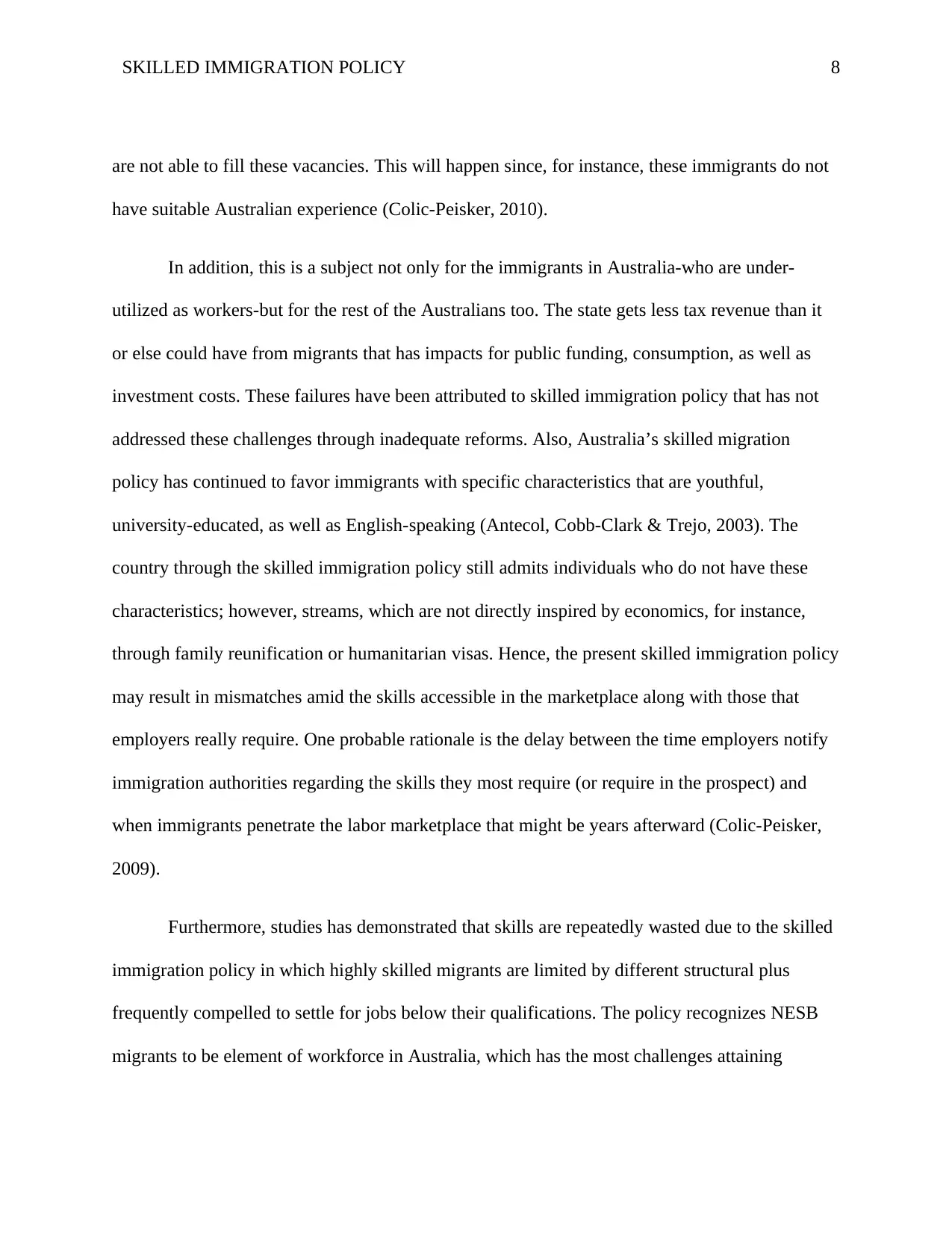
SKILLED IMMIGRATION POLICY 8
are not able to fill these vacancies. This will happen since, for instance, these immigrants do not
have suitable Australian experience (Colic-Peisker, 2010).
In addition, this is a subject not only for the immigrants in Australia-who are under-
utilized as workers-but for the rest of the Australians too. The state gets less tax revenue than it
or else could have from migrants that has impacts for public funding, consumption, as well as
investment costs. These failures have been attributed to skilled immigration policy that has not
addressed these challenges through inadequate reforms. Also, Australia’s skilled migration
policy has continued to favor immigrants with specific characteristics that are youthful,
university-educated, as well as English-speaking (Antecol, Cobb-Clark & Trejo, 2003). The
country through the skilled immigration policy still admits individuals who do not have these
characteristics; however, streams, which are not directly inspired by economics, for instance,
through family reunification or humanitarian visas. Hence, the present skilled immigration policy
may result in mismatches amid the skills accessible in the marketplace along with those that
employers really require. One probable rationale is the delay between the time employers notify
immigration authorities regarding the skills they most require (or require in the prospect) and
when immigrants penetrate the labor marketplace that might be years afterward (Colic-Peisker,
2009).
Furthermore, studies has demonstrated that skills are repeatedly wasted due to the skilled
immigration policy in which highly skilled migrants are limited by different structural plus
frequently compelled to settle for jobs below their qualifications. The policy recognizes NESB
migrants to be element of workforce in Australia, which has the most challenges attaining
are not able to fill these vacancies. This will happen since, for instance, these immigrants do not
have suitable Australian experience (Colic-Peisker, 2010).
In addition, this is a subject not only for the immigrants in Australia-who are under-
utilized as workers-but for the rest of the Australians too. The state gets less tax revenue than it
or else could have from migrants that has impacts for public funding, consumption, as well as
investment costs. These failures have been attributed to skilled immigration policy that has not
addressed these challenges through inadequate reforms. Also, Australia’s skilled migration
policy has continued to favor immigrants with specific characteristics that are youthful,
university-educated, as well as English-speaking (Antecol, Cobb-Clark & Trejo, 2003). The
country through the skilled immigration policy still admits individuals who do not have these
characteristics; however, streams, which are not directly inspired by economics, for instance,
through family reunification or humanitarian visas. Hence, the present skilled immigration policy
may result in mismatches amid the skills accessible in the marketplace along with those that
employers really require. One probable rationale is the delay between the time employers notify
immigration authorities regarding the skills they most require (or require in the prospect) and
when immigrants penetrate the labor marketplace that might be years afterward (Colic-Peisker,
2009).
Furthermore, studies has demonstrated that skills are repeatedly wasted due to the skilled
immigration policy in which highly skilled migrants are limited by different structural plus
frequently compelled to settle for jobs below their qualifications. The policy recognizes NESB
migrants to be element of workforce in Australia, which has the most challenges attaining
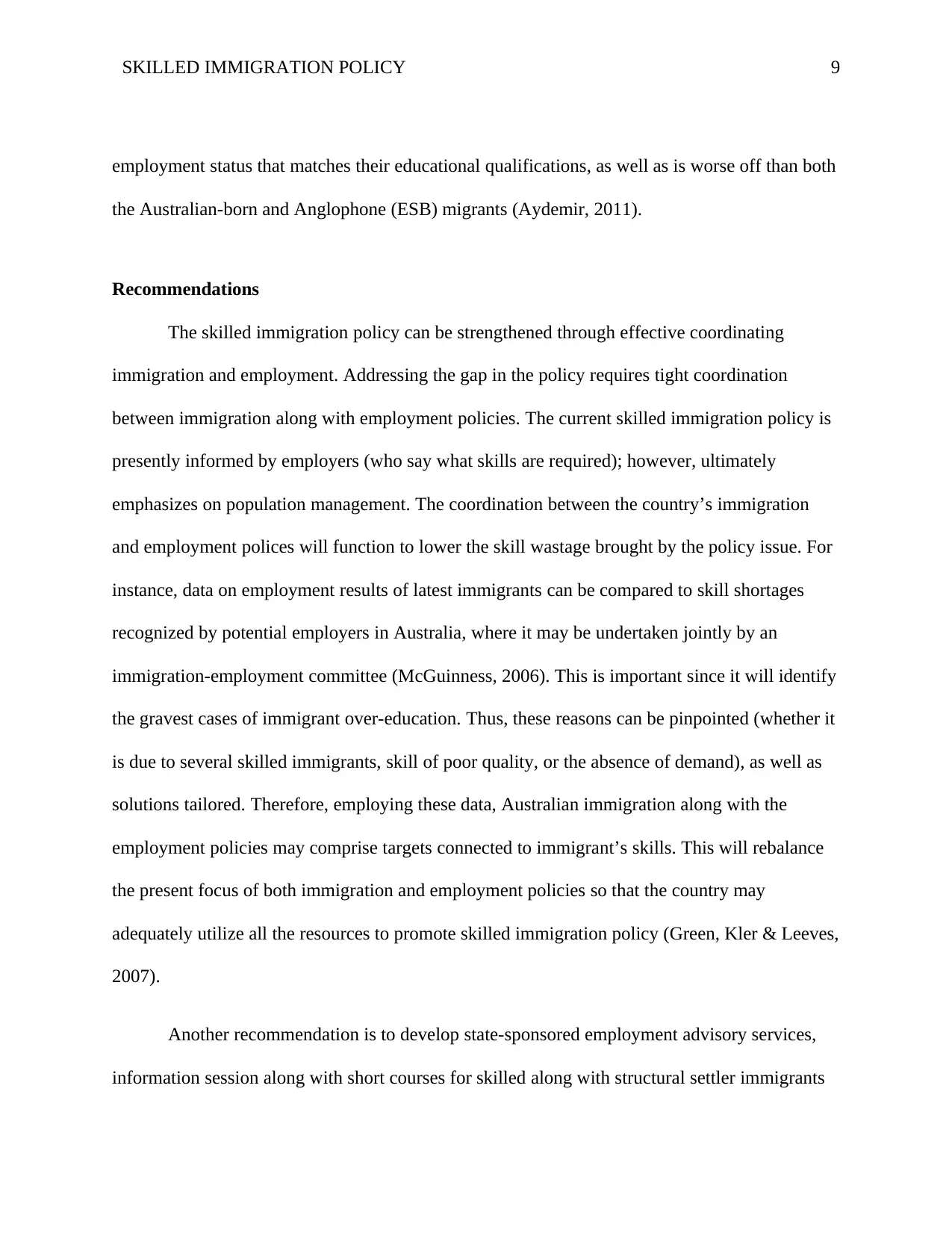
SKILLED IMMIGRATION POLICY 9
employment status that matches their educational qualifications, as well as is worse off than both
the Australian-born and Anglophone (ESB) migrants (Aydemir, 2011).
Recommendations
The skilled immigration policy can be strengthened through effective coordinating
immigration and employment. Addressing the gap in the policy requires tight coordination
between immigration along with employment policies. The current skilled immigration policy is
presently informed by employers (who say what skills are required); however, ultimately
emphasizes on population management. The coordination between the country’s immigration
and employment polices will function to lower the skill wastage brought by the policy issue. For
instance, data on employment results of latest immigrants can be compared to skill shortages
recognized by potential employers in Australia, where it may be undertaken jointly by an
immigration-employment committee (McGuinness, 2006). This is important since it will identify
the gravest cases of immigrant over-education. Thus, these reasons can be pinpointed (whether it
is due to several skilled immigrants, skill of poor quality, or the absence of demand), as well as
solutions tailored. Therefore, employing these data, Australian immigration along with the
employment policies may comprise targets connected to immigrant’s skills. This will rebalance
the present focus of both immigration and employment policies so that the country may
adequately utilize all the resources to promote skilled immigration policy (Green, Kler & Leeves,
2007).
Another recommendation is to develop state-sponsored employment advisory services,
information session along with short courses for skilled along with structural settler immigrants
employment status that matches their educational qualifications, as well as is worse off than both
the Australian-born and Anglophone (ESB) migrants (Aydemir, 2011).
Recommendations
The skilled immigration policy can be strengthened through effective coordinating
immigration and employment. Addressing the gap in the policy requires tight coordination
between immigration along with employment policies. The current skilled immigration policy is
presently informed by employers (who say what skills are required); however, ultimately
emphasizes on population management. The coordination between the country’s immigration
and employment polices will function to lower the skill wastage brought by the policy issue. For
instance, data on employment results of latest immigrants can be compared to skill shortages
recognized by potential employers in Australia, where it may be undertaken jointly by an
immigration-employment committee (McGuinness, 2006). This is important since it will identify
the gravest cases of immigrant over-education. Thus, these reasons can be pinpointed (whether it
is due to several skilled immigrants, skill of poor quality, or the absence of demand), as well as
solutions tailored. Therefore, employing these data, Australian immigration along with the
employment policies may comprise targets connected to immigrant’s skills. This will rebalance
the present focus of both immigration and employment policies so that the country may
adequately utilize all the resources to promote skilled immigration policy (Green, Kler & Leeves,
2007).
Another recommendation is to develop state-sponsored employment advisory services,
information session along with short courses for skilled along with structural settler immigrants
⊘ This is a preview!⊘
Do you want full access?
Subscribe today to unlock all pages.

Trusted by 1+ million students worldwide
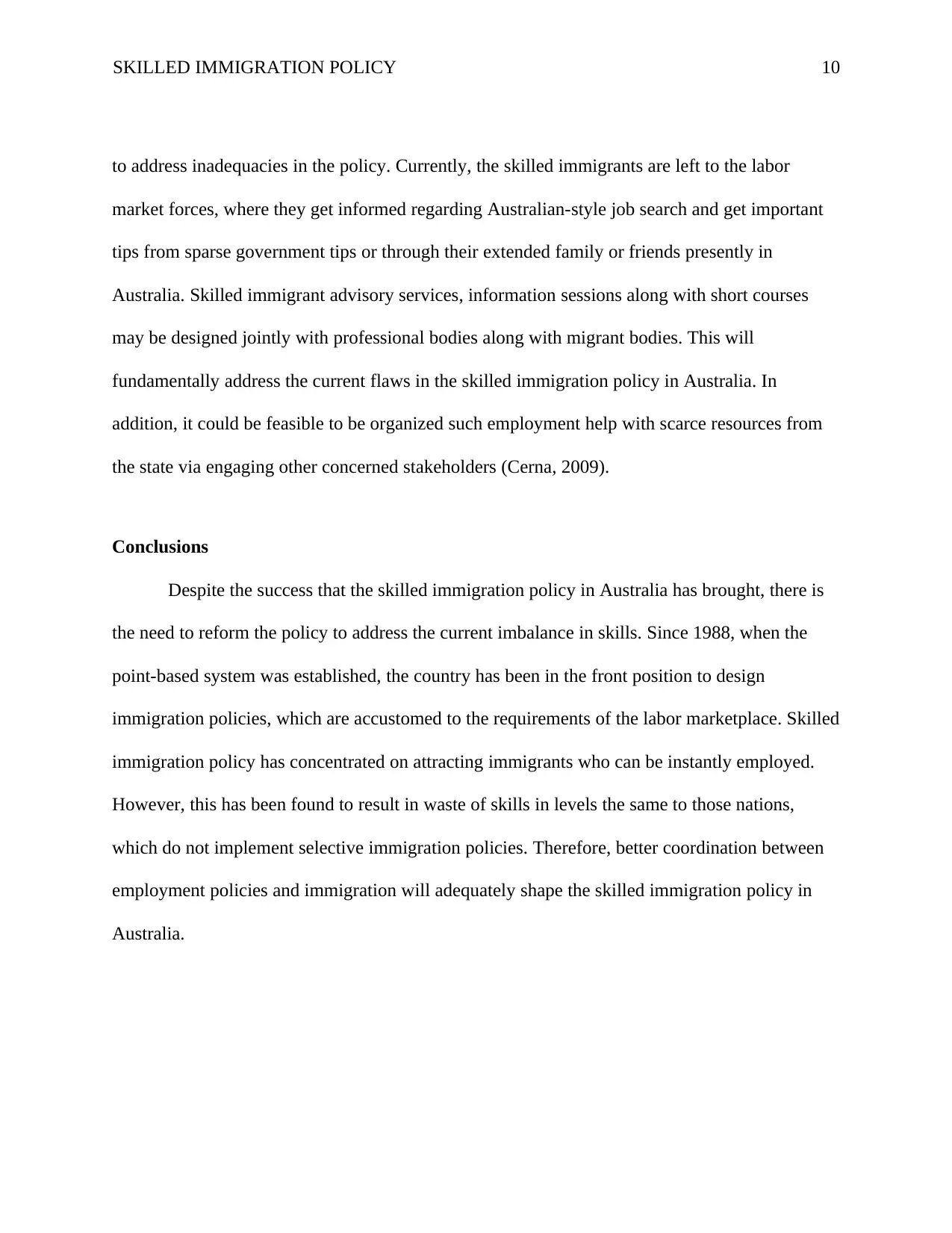
SKILLED IMMIGRATION POLICY 10
to address inadequacies in the policy. Currently, the skilled immigrants are left to the labor
market forces, where they get informed regarding Australian-style job search and get important
tips from sparse government tips or through their extended family or friends presently in
Australia. Skilled immigrant advisory services, information sessions along with short courses
may be designed jointly with professional bodies along with migrant bodies. This will
fundamentally address the current flaws in the skilled immigration policy in Australia. In
addition, it could be feasible to be organized such employment help with scarce resources from
the state via engaging other concerned stakeholders (Cerna, 2009).
Conclusions
Despite the success that the skilled immigration policy in Australia has brought, there is
the need to reform the policy to address the current imbalance in skills. Since 1988, when the
point-based system was established, the country has been in the front position to design
immigration policies, which are accustomed to the requirements of the labor marketplace. Skilled
immigration policy has concentrated on attracting immigrants who can be instantly employed.
However, this has been found to result in waste of skills in levels the same to those nations,
which do not implement selective immigration policies. Therefore, better coordination between
employment policies and immigration will adequately shape the skilled immigration policy in
Australia.
to address inadequacies in the policy. Currently, the skilled immigrants are left to the labor
market forces, where they get informed regarding Australian-style job search and get important
tips from sparse government tips or through their extended family or friends presently in
Australia. Skilled immigrant advisory services, information sessions along with short courses
may be designed jointly with professional bodies along with migrant bodies. This will
fundamentally address the current flaws in the skilled immigration policy in Australia. In
addition, it could be feasible to be organized such employment help with scarce resources from
the state via engaging other concerned stakeholders (Cerna, 2009).
Conclusions
Despite the success that the skilled immigration policy in Australia has brought, there is
the need to reform the policy to address the current imbalance in skills. Since 1988, when the
point-based system was established, the country has been in the front position to design
immigration policies, which are accustomed to the requirements of the labor marketplace. Skilled
immigration policy has concentrated on attracting immigrants who can be instantly employed.
However, this has been found to result in waste of skills in levels the same to those nations,
which do not implement selective immigration policies. Therefore, better coordination between
employment policies and immigration will adequately shape the skilled immigration policy in
Australia.
Paraphrase This Document
Need a fresh take? Get an instant paraphrase of this document with our AI Paraphraser
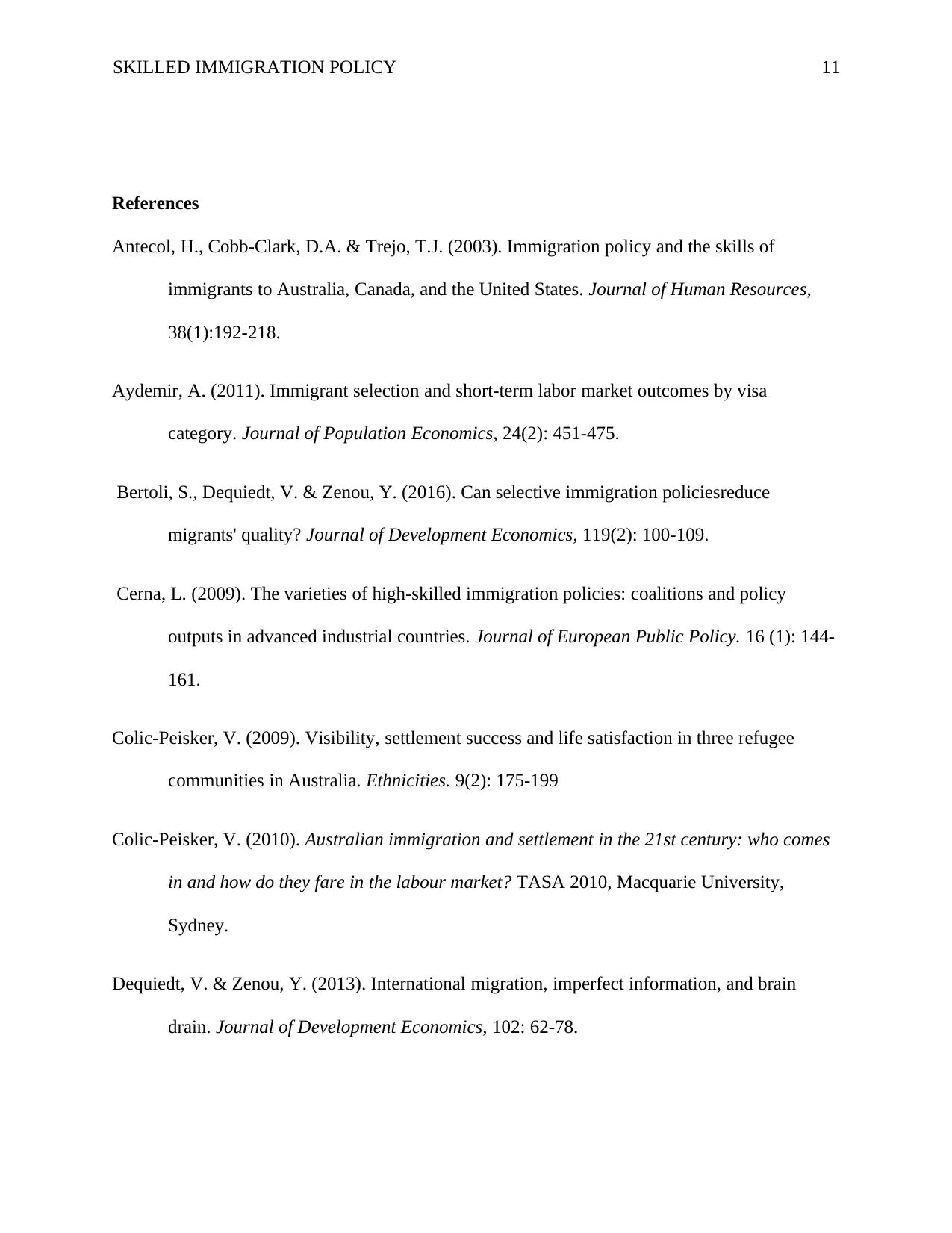
SKILLED IMMIGRATION POLICY 11
References
Antecol, H., Cobb-Clark, D.A. & Trejo, T.J. (2003). Immigration policy and the skills of
immigrants to Australia, Canada, and the United States. Journal of Human Resources,
38(1):192-218.
Aydemir, A. (2011). Immigrant selection and short-term labor market outcomes by visa
category. Journal of Population Economics, 24(2): 451-475.
Bertoli, S., Dequiedt, V. & Zenou, Y. (2016). Can selective immigration policiesreduce
migrants' quality? Journal of Development Economics, 119(2): 100-109.
Cerna, L. (2009). The varieties of high-skilled immigration policies: coalitions and policy
outputs in advanced industrial countries. Journal of European Public Policy. 16 (1): 144-
161.
Colic-Peisker, V. (2009). Visibility, settlement success and life satisfaction in three refugee
communities in Australia. Ethnicities. 9(2): 175-199
Colic-Peisker, V. (2010). Australian immigration and settlement in the 21st century: who comes
in and how do they fare in the labour market? TASA 2010, Macquarie University,
Sydney.
Dequiedt, V. & Zenou, Y. (2013). International migration, imperfect information, and brain
drain. Journal of Development Economics, 102: 62-78.
References
Antecol, H., Cobb-Clark, D.A. & Trejo, T.J. (2003). Immigration policy and the skills of
immigrants to Australia, Canada, and the United States. Journal of Human Resources,
38(1):192-218.
Aydemir, A. (2011). Immigrant selection and short-term labor market outcomes by visa
category. Journal of Population Economics, 24(2): 451-475.
Bertoli, S., Dequiedt, V. & Zenou, Y. (2016). Can selective immigration policiesreduce
migrants' quality? Journal of Development Economics, 119(2): 100-109.
Cerna, L. (2009). The varieties of high-skilled immigration policies: coalitions and policy
outputs in advanced industrial countries. Journal of European Public Policy. 16 (1): 144-
161.
Colic-Peisker, V. (2009). Visibility, settlement success and life satisfaction in three refugee
communities in Australia. Ethnicities. 9(2): 175-199
Colic-Peisker, V. (2010). Australian immigration and settlement in the 21st century: who comes
in and how do they fare in the labour market? TASA 2010, Macquarie University,
Sydney.
Dequiedt, V. & Zenou, Y. (2013). International migration, imperfect information, and brain
drain. Journal of Development Economics, 102: 62-78.
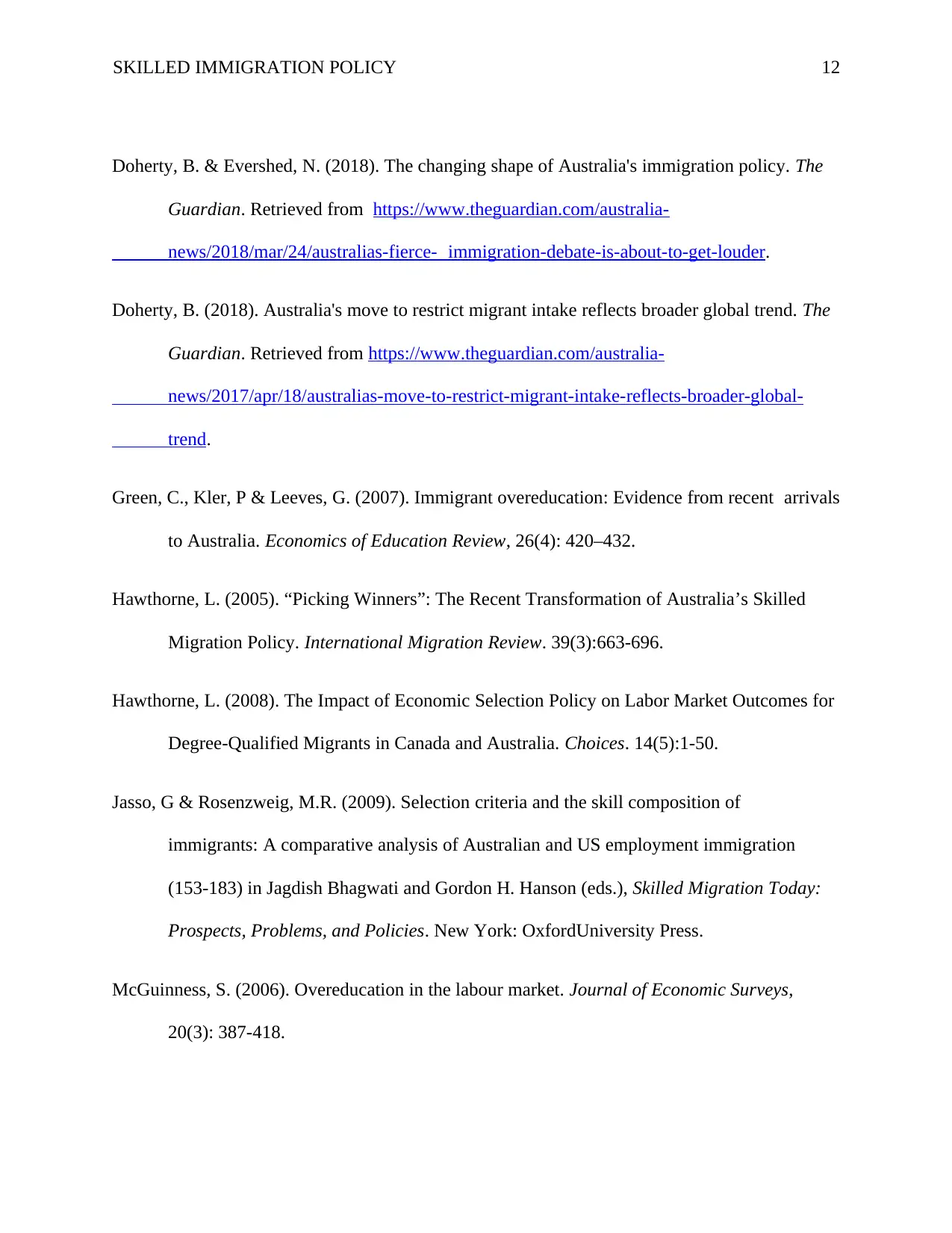
SKILLED IMMIGRATION POLICY 12
Doherty, B. & Evershed, N. (2018). The changing shape of Australia's immigration policy. The
Guardian. Retrieved from https://www.theguardian.com/australia-
news/2018/mar/24/australias-fierce- immigration-debate-is-about-to-get-louder.
Doherty, B. (2018). Australia's move to restrict migrant intake reflects broader global trend. The
Guardian. Retrieved from https://www.theguardian.com/australia-
news/2017/apr/18/australias-move-to-restrict-migrant-intake-reflects-broader-global-
trend.
Green, C., Kler, P & Leeves, G. (2007). Immigrant overeducation: Evidence from recent arrivals
to Australia. Economics of Education Review, 26(4): 420–432.
Hawthorne, L. (2005). “Picking Winners”: The Recent Transformation of Australia’s Skilled
Migration Policy. International Migration Review. 39(3):663-696.
Hawthorne, L. (2008). The Impact of Economic Selection Policy on Labor Market Outcomes for
Degree-Qualified Migrants in Canada and Australia. Choices. 14(5):1-50.
Jasso, G & Rosenzweig, M.R. (2009). Selection criteria and the skill composition of
immigrants: A comparative analysis of Australian and US employment immigration
(153-183) in Jagdish Bhagwati and Gordon H. Hanson (eds.), Skilled Migration Today:
Prospects, Problems, and Policies. New York: OxfordUniversity Press.
McGuinness, S. (2006). Overeducation in the labour market. Journal of Economic Surveys,
20(3): 387-418.
Doherty, B. & Evershed, N. (2018). The changing shape of Australia's immigration policy. The
Guardian. Retrieved from https://www.theguardian.com/australia-
news/2018/mar/24/australias-fierce- immigration-debate-is-about-to-get-louder.
Doherty, B. (2018). Australia's move to restrict migrant intake reflects broader global trend. The
Guardian. Retrieved from https://www.theguardian.com/australia-
news/2017/apr/18/australias-move-to-restrict-migrant-intake-reflects-broader-global-
trend.
Green, C., Kler, P & Leeves, G. (2007). Immigrant overeducation: Evidence from recent arrivals
to Australia. Economics of Education Review, 26(4): 420–432.
Hawthorne, L. (2005). “Picking Winners”: The Recent Transformation of Australia’s Skilled
Migration Policy. International Migration Review. 39(3):663-696.
Hawthorne, L. (2008). The Impact of Economic Selection Policy on Labor Market Outcomes for
Degree-Qualified Migrants in Canada and Australia. Choices. 14(5):1-50.
Jasso, G & Rosenzweig, M.R. (2009). Selection criteria and the skill composition of
immigrants: A comparative analysis of Australian and US employment immigration
(153-183) in Jagdish Bhagwati and Gordon H. Hanson (eds.), Skilled Migration Today:
Prospects, Problems, and Policies. New York: OxfordUniversity Press.
McGuinness, S. (2006). Overeducation in the labour market. Journal of Economic Surveys,
20(3): 387-418.
⊘ This is a preview!⊘
Do you want full access?
Subscribe today to unlock all pages.

Trusted by 1+ million students worldwide
1 out of 13
Related Documents
Your All-in-One AI-Powered Toolkit for Academic Success.
+13062052269
info@desklib.com
Available 24*7 on WhatsApp / Email
![[object Object]](/_next/static/media/star-bottom.7253800d.svg)
Unlock your academic potential
Copyright © 2020–2025 A2Z Services. All Rights Reserved. Developed and managed by ZUCOL.



